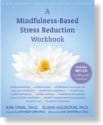Barry Boyce talks to the authors of the new, groundbreaking interactive book, A Mindfulness-Based Stress Reduction Workbook, and reports on his visit to the annual gathering at the Center for Mindfulness.
Jon Kabat-Zinn has this story he likes to tell about the early days of the stress reduction clinic at the University of Massachusetts Medical Center in Worcester. It was 1979 and he had found space in a basement room to offer training to a few patients who—like most people who take up Mindfulness-Based Stress Reduction—were looking for relief from pain. The participants were spread out around the room, lying on their backs on the floor, when a squad of doctors in white lab coats stormed in. They wanted to know what was going on. Kabat-Zinn told them his group was scheduled to use the space, and the head doctor responded, “Are these our patients?” Told that was indeed the case, the doctor didn’t protest. “Very well then,” he said, “we’ll find another room.”
Kabat-Zinn recounts this incident to illustrate that a crucial reason for the acceptance and spread of MBSR is that, in essence, it’s simply about helping people. However, another key component is the way that he and Saki Santorelli, director of the Center for Mindfulness in Medicine, Health Care, and Society, have protected the integrity of the eight-week program—now completed by more than eighteen thousand people and offered in over 250 hospitals—without trying to exert strong control over it. They’ve provided guidance to people who have developed offshoots, so long as the offshoots aren’t called MBSR, and they have allowed the elements that make up the program to be offered in creative ways.
One of the latest projects they’ve given their blessing to is the publication of A Mindfulness-Based Stress Reduction Workbook, by Bob Stahl and Elisha Goldstein. The book, which provides graded, guided instruction and inquiry supplemented with audio instructions, grew out of work Stahl and Goldstein did on providing stress reduction training through distance learning. Users of the workbook are encouraged to engage in the readings and practices according to a timeline and to connect with others who are doing the same through the www.mbsrworkbook.com website.
The authors see the workbook as a “technology” that goes beyond the traditional book: readers are regarded as users who can become part of a loosely organized community through the website and social networking tools like Facebook. The book reaches out to people who are, as Stahl told me, in “pain, stress, and difficulty, as I have been.” Rather than a “static read,” it is conceived of as a guidebook for a journey.
Stahl studied Eastern religions and learned Vipassana meditation in the seventies, and traveled to Burma in 1980 to study with Ven. Taungpulu Sayadaw. After about six months, he returned to the United States with his teacher and became one of the founders of Taungpulu Kaba Aye monastery in Boulder Creek, California. After living at the monastery for eight years, Stahl left to work at a clinic in Santa Cruz with patients suffering from neurological disorders. “I began teaching them mindfulness,” Stahl says, “and I was so moved by the results. One elderly lady told me, ‘This mindfulness stuff is keeping me out of the nursing home, because when I go to pee in the middle of the night, I’m mindful of each step. Otherwise, I’d fall and break my hip, and that would be that.’”
While doing this work, Stahl stumbled upon Kabat-Zinn’s books and wrote to him seeking advice. The response he received led to his becoming a senior MBSR teacher and a leader within the MBSR movement. Goldstein, who now has a mindfulness- based psychotherapy practice in Los Angeles, encountered his coauthor when Stahl became a member of his dissertation committee at the Institute of Transpersonal Psychology. He began studying with Stahl, who was two decades his senior and became a mentor for him. Goldstein soon began trying to persuade Stahl that an online course in stress reduction would be “a very effective and bene cial therapeutic tool.” The monk in Stahl at first resisted the idea of high-tech meditation training, but as Goldstein drew him further into the project, Stahl said, “I thought, wow, we have the beginnings of an MBSR workbook. It would take a lot of work, but if we collaborated we could make it happen.”
The authors intend to continue to support the community that develops from the workbook through regular video blogs and responding to questions that arise through social network- ing. “Sure, this is a bit of an experiment and we want to be careful that people don’t misuse this,” Goldstein said, “but we’ve created the workbook in such a way that if someone doesn’t know any- thing about mindfulness they’ll be able to put their hands on it and begin to practice a variety of basic mindfulness skills— mindful walking and eating, mindfulness of emotions, loving- kindness, communication, and many others. But we also want it to be a warm, connected, communal experience, so that people will want to deepen those skills. We are clear that this is not a substitute for taking an MBSR course, but we believe many peo- ple will be led in that direction.”
The Center for Mindfulness held its Eighth Annual International Conference for Clinicians, Researchers, and Educators in April in Worcester. Some four hundred people chose from a menu of about fifty sessions, including mindfulness for police officers, creating campus mindfulness groups, and using MBSR to treat post-traumatic stress disorder in people who’ve suffered sexual trauma.
In a keynote address, David Eisenberg MD, a pioneer in integrative medicine who spent the early phase of his career in China learning acupuncture, tai chi, and herbal medicine, discussed the future of mindfulness in medical care. He pointed out that labels such as alternative or complementary that the national Institutes of Health (nIH) and other institutions have used to identify holistic, mind–body medicine perpetuate the idea that such disciplines remain separate from the mainstream rather than be- ing integrated into standard care. He went on to discuss an nIH- funded pilot study that is testing a model of integrative medical care that includes mindfulness as a core component. Steinberg concluded by emphasizing that future research involving mind- fulness would need to track cost-effectiveness. He argued that political and institutional support for integrating mindfulness into standard health care would increase only as its potential to lower health care costs for many conditions is demonstrated.
Democratic Congressman Timothy Ryan of Ohio—the featured speaker at a gala event celebrating the center’s entering its fourth decade of work–echoed and reinforced Steinberg’s point about cost-savings. Ryan, who practices mindfulness and yoga, asked for the attendees’ support in helping put mindfulness on the health care agenda in Washington. “Contact your representative or senator,” he said, “and let them know about the work you are doing and who it is helping. Let me know what you are doing. I need your help.”

